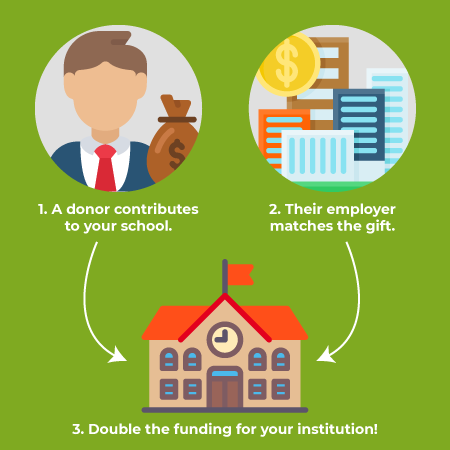At Fundraising IP, we know a lot about matching gifts and how they go to elevate fundraising at institutions of all shapes, sizes, and missions. Here, we’ll focus on matching gifts and higher education organizations like colleges and universities.
Unfortunately, research by matching gift experts reports that billions of available matching dollars go unclaimed by eligible donors and institutions each year. That’s why we’ve gotten together with these experts to provide readers with unique and impactful insights as they aim to revamp their strategies and raise more through the funding source.
Let’s begin!
Q — How would you briefly describe matching gift fundraising?
 A — Matching gift fundraising is the process used by nonprofits and other fundraising organizations—such as higher education institutions—to increase matching gift participation and collect an increasing number of corporate matches. These corporate matches are being made available by tens of thousands of companies that agree to financially match donations their employees make to qualifying nonprofit causes.
A — Matching gift fundraising is the process used by nonprofits and other fundraising organizations—such as higher education institutions—to increase matching gift participation and collect an increasing number of corporate matches. These corporate matches are being made available by tens of thousands of companies that agree to financially match donations their employees make to qualifying nonprofit causes.
So, let’s say a person donates $1,000 to your school. When they secure a corporate match from their employer, the company provides an additional thousand—bringing the total value of the gift to $2,000.
As you can see, it’s a great way to increase funding for your institution—all without having to ask donors to reach back into their own wallets. And donors love participating in the programs, too!
Of course, there is a lot to learn about the matching gift industry, so be sure to access additional materials if you want to dive deeper. The Matching Gift Academy from Double the Donation is a great place to start.
Q — It’s clear how nonprofits and schools benefit from matching gifts—but what’s in it for the companies?
A — There are tons of advantages to matching gifts and higher education, spread among each party involved. These typically begin with schools getting increased funding and donors seeing their gifts being stretched further.
What some people might not know, however, is that participating companies see some of the greatest benefits of matching gifts—which is why they typically develop matching gift programs in the first place.
These benefits typically fall within one of two categories: internal or external. Internal corporate benefits of workplace giving (and particularly matching gifts) include things like improved company culture, heightened levels of employee engagement, reduced staff turnover, and even recruitment advantages. People like working for companies that make a positive impact on the world beyond their own bottom lines—and matching gifts are an especially effective way to do that.
At the same time, external benefits of matching gifts include boosted marketing opportunities, positive brand reputation, and ultimately higher sales. People also like buying from companies that make a positive impact, so the programs quite literally pay off!
Q — What kinds of institutions are eligible to receive matching gift funding?
A — The short answer is that many 501(c)(3) organizations are eligible to receive matching gift funding from thousands of companies with these programs. The longer answer is that, unfortunately, the exact eligibility criteria vary from business to business.
Most companies will choose one or more categories of nonprofit missions (such as schools, health and human services, arts and culture, civic and community, environmental, and more) to which they agree to match donations. Common exclusions, on the other hand, include polarizing or controversial types of organizations—the most typical being religiously-affiliated and political organizations.
If a donor or fundraiser was aiming to determine which types of organizations a particular company will match, we recommend utilizing a matching gift tool to locate the information.
Q — How do matching gifts for higher education institutions compare to matching gifts for other nonprofits or K-12 schools?
A — When it comes to matching gifts and higher education institutions, and matching gifts and other types of schools and nonprofits, one of the biggest differences has to do with eligibility criteria. Of all types of nonprofit missions, colleges and universities are the most likely to be matched by tens of thousands of companies. That’s great news for you and your school!
As a fun fact, many companies’ workplace giving programs were historically designed in order to provide matches solely to higher education institutions. In the years since, however, we’ve seen significant expansion into other nonprofit missions and school types as well.
Q — What are some companies that match gifts to higher education institutions? How can you locate this information?
A — There are a few ways an organization can locate information on companies with matching gift programs. One popular method involves simply conducting an online search for companies that match gifts to colleges and universities. When you do so, you’ll likely see high-ranking lists such as those on the Double the Donation and 360MatchPro websites as thought leaders in the space.
For example, this Double the Donation compilation reports on companies with generous matching gift programs that specifically match donations to higher education institutions. On the other hand, this list incorporates all sorts of companies with matching gift programs (the good news being that the vast majority of matching gift businesses will donate to colleges and universities). A few top contenders on each list include Allstate Insurance, ExxonMobil, Coca-Cola, The Walt Disney Corporation, and more.
Alternatively, one of the most efficient ways to uncover companies that match gifts to higher education is with a matching gift database. In this case, all a person needs to do (regardless of whether they’re a donor or a development professional) is begin typing a business’ name in the online tool’s search field. Information on the company’s matching gift offerings is then pulled from a comprehensive database of thousands of programs and made available to the searcher within seconds.
Q — What does the matching gift opportunity look like by the numbers? Are most eligible donations being matched?
A — Matching gifts offer a significant giving opportunity for higher education institutions, along with other 501(c)(3) organizations of all shapes and sizes. In fact, the opportunity available is often much larger than many donors and fundraising teams even know!
According to statistics from Fundraising IP and Double the Donation, $2-3 billion is donated through matching gift programs each year—which is approximately 11% of total corporate cash contributions made to nonprofits. However, more than twice that amount goes unclaimed by eligible donors and nonprofits, meaning $4 to $7 billion in available match revenue is left on the table on an annual basis.
One of the biggest reasons for the massive disparity is that, despite over 26 million individuals being eligible to participate in the programs, more than 78% of the group has never been made aware of matching gift opportunities in the first place!
Q — What is your #1 piece of advice that you would give to a college or university looking to increase matching gifts?
A — Our number 1 piece of advice for higher education institutions and other nonprofits looking to drive corporate gift-matching is to prioritize the funding source within your overall fundraising strategy.
The limitations of corporate fundraising (that are faced by thousands of organizations alike) often come to a head when fundraisers treat matching gift initiatives as a passive form of income. While sure, it’s possible to collect matches this way—by sitting back and waiting for the corporate gifts to roll in—organizations taking this approach are likely to miss out on a ton of potential revenue.
That’s why we strongly recommend that fundraisers take a proactive approach to matching gift fundraising. In fact, one of the best things you can do to drive matching gifts is to walk alongside donors. For example, be sure to inform them of the programs’ existence in the first place, provide company-specific guidelines about their employers’ opportunities, and otherwise assist them in navigating workplace giving participation to better equip donors for the process involved.
Q — What are some of the most important tools that can help drive more matching gift funds?
A — As a higher education fundraiser, you surely understand the importance of equipping your team with the right tools for giving and fundraising success. Matching gifts are no different, and luckily, there are a wide array of tools available to help.
To get started with maximizing matching gifts for your school, the #1 resource you’ll need is a matching gift database. We mentioned this tool earlier, as it plays such a critical role in matching gift fundraising success. With the right database solution, an institution can simply embed the provided search tool within their online donation forms, create a dedicated matching gift page on its website, and provide donors with direct access from (automated) donation follow-up communications as well.
Not to mention, it can be extremely simple to get up and running with the best-in-class matching gift software, especially when it integrates with the fundraising platforms your school is already using. For example, we know that Fundraising IP has compiled several lists of top online giving websites, peer-to-peer tools, and fundraising CRMs that are designed and integrated with dedicated matching gift functionality in mind. Or, Double the Donation has even put together this compilation of school and higher education-specific fundraising platforms with matching gift functionality!
With the right tools in your college or university’s toolkit, you’ll be all set to rake in the matching gift dollars without your team even having to lift a finger.
Q — What next steps should a college or university take now?
A — If you’re reading this and are ready to get started with elevated matching gift fundraising for your school (which you should be!), we recommend reaching out to the team of fundraising experts at Double the Donation. Learn more about effective matching gifts and higher education strategies, and request a demo of their product to begin.
Read now: How to Navigate Workplace Giving: 5 Ways to Help Your Donors

